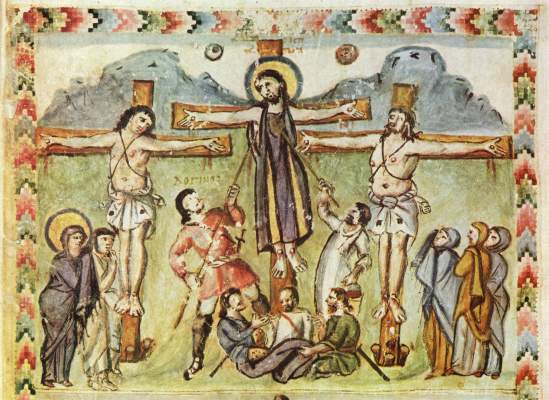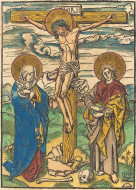
 |
Freethought & Rationalism ArchiveThe archives are read only. |
|
|
#1 |
|
Veteran Member
Join Date: Sep 2004
Location: Birmingham UK
Posts: 4,876
|
Freke and Gandy used as the frontispiece of The Jesus Mysteries an amulet now lost showing a crucified figure with the inscription ORPhEOS BAKKIKOS. If authentic this amulet would probably date from c 300 CE.
There have been claims at Bede's blog http://bedejournal.blogspot.com/2006...l_archive.html http://bedejournal.blogspot.com/2004...crucified.html and elsewhere http://sternfels.blogspot.com/2006/0...us-amulet.html that this amulet was a (probably 19th century) forgery These claims ultimately go back to a 1926 German article in AGGELOS I've tracked down this article and althuogh my academic German is too poor for me to offer a translation I can give a paraphrase. The major part of the article is a long section by Johannes Reil who sees no problems with authenticity on technological grounds (ie the amulet could have been carved using the techniques of late antiquity). However he has several problems with the iconography. 1/ The depiction of the crucified figure is medieval rather than Late Antique (I'll discuss this in more detail below) 2/ The cross is Latin in shape + as in later depictions of crucifixion rather than the T shaped cross (and other variants) typical before 500 CE. 3/ The depiction of the crucified figure as alone withuot crucifiers co-crucified or devotees is unparalleled in antiquity and only appears later. In the light of modern knowledge 2/ and 3/ may be less evidential than Reil supposes although IIUC there is still no example from antiquity of a solitary crucified figure on a Latin cross. 4/ The image of the moon and seven stars is very strange but may be a later development of the early symbolic use of the sun and moon in images of the crucifixion with the sun removed in response to the claim in the synoptic Gospels that the sun was darkened. I find this plausible myself others will regard it as speculative. Point 1/ is IMO the strongest argument and I regard it as compelling. The figure on the amulet has bent legs brought together at the feet and hangs from bent arms this is characteristically medieval in contrast to the stright upright figure usual in images of the crucifixion from antiquity. I will try and illustrate this below First 2 antique crucifixion scenes  Now 2 images of the amulet  Finally some medieval images    It should be clear how the crucified figure resembles the medieval rather than the antique examples. (For further study of the iconography of the crucifixion http://www.textweek.com/art/crucifixion.htm is a good site) Andrew Criddle |
|
|
|
|
#2 |
|
Regular Member
Join Date: Nov 2003
Location: SD, USA
Posts: 268
|
Although I was suspicious of this "crucified Orpheus" amulet when I first saw it, and still am, I know I have seen an ancient crucifixion picture that has both legs bent up more drastically than either the "Orpheus" or the Medieval examples shown here. Also, the knees were facing sideways rather than toward the viewer, if you can picture what I'm talking about. I hope I can recollect what book I saw this in, as I'm sure no one is going to take my word for it.
How is the fact that Orpheus was dismembered and not crucified accounted for by this theory? |
|
|
|
|
#3 | |
|
Veteran Member
Join Date: Oct 2005
Location: In the torture chambers of Pinochet's Chile
Posts: 2,112
|
Quote:
|
|
|
|
|
|
#4 | |||
|
Veteran Member
Join Date: Sep 2004
Location: Birmingham UK
Posts: 4,876
|
Quote:
Note the hanging arms in the Alexamenos graffiti (c 200 CE) http://penelope.uchicago.edu/~grout/.../graffito.html Also Johannes Reil in his article says Quote:
Quote:
a/ the figure in the Orpheus amulet taken as a whole resembles medieval rather than Late Antique depictions b/ In the Orpheus amulet the lower legs and feet are brought together in a way that is standard in medieval Latin representations but seems unparalleled in the earliest depictions of the crucifixion. Andrew Criddle |
|||
|
|
|
|
#5 | |
|
Veteran Member
Join Date: Sep 2004
Location: Birmingham UK
Posts: 4,876
|
I've been investigating further the iconography of crucifixion and how it relates to the Orpheus amulet and felt it worth posting my findings
Among my main sources are the intersting web page http://www.aug.edu/augusta/iconography/crucifixion.html and the interesting book Byzantine Art by Robin Cormack. Early representations of the crucifixion are generally of the Christus Victor type with little indication of suffering and death and with Christ almost 'reigning from the cross'. Later the Christus Patiens type becomes prominent with the suffering and death of the crucified saviour made more prominent. This later develops particularly in the Western tradition after 1000 CE into images emphasising the pathos of the crucifixion and designed to encourage meditation on Christ's suffering. If authentic the letter shapes of the Orpheus amulet indicate a date no later than 400 CE. However this amulet is clearly of the Christus Patiens and in some ways a late form of this type. However, this way of depicting the crucifixion develops well after the middle of the 1st millennium with the main early examples 8th and 9th century Canon 82 from the council in Trullo in 692 Quote:
Hence the Orpheus amulet taken at face value dates from 400 CE or earlier, but iconographically makes little sense in the pre-Islamic world. Andrew Criddle |
|
|
|
|
|
#6 | |
|
Veteran Member
Join Date: Jan 2005
Location: USA
Posts: 1,307
|
Quote:
Stephen Carlson |
|
|
|
|
|
#7 |
|
Junior Member
Join Date: May 2005
Location: de
Posts: 64
|
New article, new approach:
English: http://www.carotta.de/subseite/texte...akkikos_en.pdf German: http://www.carotta.de/subseite/texte...akkikos_de.pdf |
|
|
|
|
#8 | |
|
Contributor
Join Date: Mar 2003
Location: London UK
Posts: 16,024
|
Fascinating.
Especially the comment about the Eucharist ritual deriving directly from the Imperial Cult. And this term "xian". I would seriously research annointing rituals and the development of cults around that. The true gods and perfumes..... Love the comment about people assuming artefacts are xian and are depicting a crucifixion! Quote:
|
|
|
|
|
|
#9 | ||
|
Contributor
Join Date: Mar 2003
Location: London UK
Posts: 16,024
|
Quote:
Quote:
Nothing like a good dose of parallelism!:devil1: |
||
|
|
| Thread Tools | Search this Thread |
|